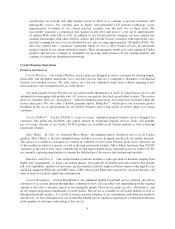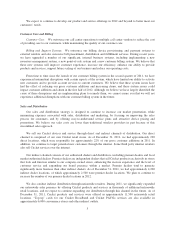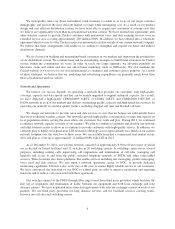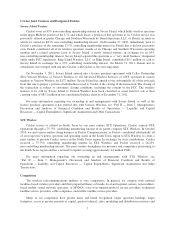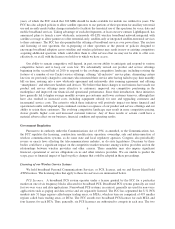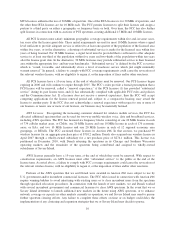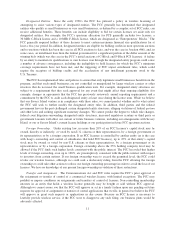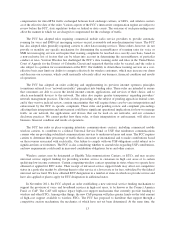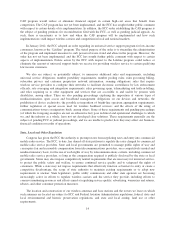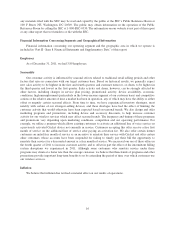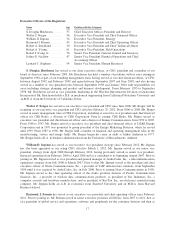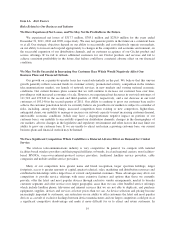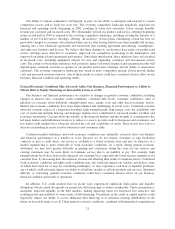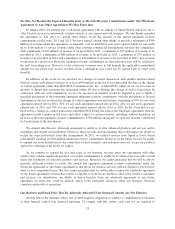Cricket Wireless 2011 Annual Report Download - page 23
Download and view the complete annual report
Please find page 23 of the 2011 Cricket Wireless annual report below. You can navigate through the pages in the report by either clicking on the pages listed below, or by using the keyword search tool below to find specific information within the annual report.compensation for intra-MTA traffic exchanged between local exchange carriers, or LECs, and wireless carriers
as of the effective date of the order. Various aspects of the FCC’s intercarrier compensation regime are subject to
review before the FCC, state regulatory bodies or federal or state courts. The outcome of such proceedings may
affect the manner in which we are charged or compensated for the exchange of traffic.
The FCC has adopted rules requiring commercial mobile radio service providers to provide automatic
roaming for voice and SMS text messaging services on just, reasonable and non-discriminatory terms. The FCC
has also adopted rules generally requiring carriers to offer data roaming services. These orders, however, do not
provide or mandate any specific mechanism for determining the reasonableness of roaming rates for voice or
SMS text messaging services and require that roaming complaints be resolved on a case-by-case basis, based on
a non-exclusive list of factors that can be taken into account in determining the reasonableness of particular
conduct or rates. Verizon Wireless has challenged the FCC’s data roaming order and rules in the United States
Court of Appeals for the District of Columbia Circuit and requested that the rules be vacated, and the order is
also subject to a petition for reconsideration at the FCC. Our inability to obtain these roaming services on a cost-
effective basis may limit our ability to compete effectively for wireless customers, which may increase our churn
and decrease our revenues, which could materially adversely affect our business, financial condition and results
of operations.
The FCC has adopted an order codifying and supplementing its previous internet openness principles
(sometimes referred to as “network neutrality” principles) into binding rules. These rules are intended to ensure
that consumers are able to access the lawful internet content, applications, and services of their choice, and to
attach non-harmful devices to the network. The rules also require greater transparency regarding providers’
network management practices. The rules in this proceeding are the subject of pending appeals in federal court,
and if they survive judicial review, contain uncertainties that will require future case-by-case interpretation and
enforcement by the FCC in specific complaints. These rules and pending review and complaint proceedings
affecting their interpretation and enforcement could have significant operational implications for how we manage
traffic on our network, the applications and devices that can be used on our networks, and our consumer
disclosure practices. We cannot predict how these rules, or their interpretation or enforcement, will affect our
business, financial condition and results of operations.
The FCC has rules in place requiring interstate communications carriers, including commercial mobile
wireless carriers, to contribute to a federal Universal Service Fund, or USF, that reimburses communications
carriers who are providing subsidized communications services to underserved areas and users. The FCC requires
carriers to determine their percentage of traffic that is interstate or international and to make contributions based
on the revenues associated with such traffic. Our failure to comply with our USF obligations could subject us to
significant fines or forfeitures. The FCC is also considering whether to amend rules regarding USF contributions,
and new requirements could result in increased contribution obligations for us and other carriers.
Wireless carriers may be designated as Eligible Telecommunications Carriers, or ETCs, and may receive
universal service support funding for providing wireless service to customers in high cost areas or to certain
qualifying low income customers. Certain competing wireless carriers operating in states where we operate have
obtained or applied for ETC status. Their receipt of universal service support funds may affect our competitive
status in a particular market by allowing them to offer service at a lower rate or for free, subsidized by the federal
universal service fund. We have obtained ETC designation in a number of states in which we provide service and
have also applied or plan to apply for ETC designation in additional states.
In November 2011, the FCC adopted an order establishing a new universal service funding mechanism to
support the provision of voice and broadband services in high-cost areas, to be known as the Connect America
Fund, or CAF. The CAF will replace legacy high-cost support mechanisms that currently provide funding to
wireless and other ETCs. Among other things, the new CAF program will place greater limits on the total amount
of high-cost support available to wireless ETCs. The FCC has proposed to distribute that support through a
competitive auction mechanism, the mechanics of which have not yet been determined. At the same time, the
13



